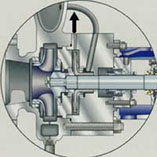Basic Split Flow™ facts and applications
What is Split Flow?
Split Flow™ is a patented feature for an API (American Petroleum Institute) Standard 610 centrifugal pump.
Why the name "Split Flow"?
The Split Flow application separates the pump's inlet flow into two separate flowstreams, thus creating
a primary high-flow, low-head discharge and a secondary
lower-flow, higher-head discharge. The Split Flow design incorporates a low-flow auxiliary
impeller which receives inlet liquid from the discharge of the primary impeller.
What are the benefits of Split Flow?
When process designs use API Standard 610 centrifugal pumps for Dual-Service
applications, use of the Split Flow feature provides unique benefits,
including:
- Permits use of two pumps instead of four, resulting in significant capital savings;
- Allows use of smaller motors, lowering kilowatt usage;
- Provides better pump-to-system hydraulic fit, references: API
Standard 610 criteria and juxtaposed curves;
- Results in longer MTBR (mean time between repairs) for seals and bearings.
Little
Split Flow is used with single-stage, overhung-type pumps
(horizontal or vertical inline) up to 200 hp. The feature allows for
use of smaller diameter impellers. Impeller diameter can be a restraining
parameter for some overhung pump services.
For larger sizes, Big Split Flow may be used with multi-stage,
between-bearings API type pumps, e.g. two-stage radial split case
(for rated temperature up to 800°F) or multi-stage horizontal
split case types for service temperatures below 400°F and specific
gravities above 0.70.
See schematic of criteria for use of Split Flow.
|

